Nike Inc. Business Analysis: Agency Theory, Game Theory & SET Analysis
VerifiedAdded on 2023/06/03
|18
|4606
|123
Report
AI Summary
This report provides a comprehensive analysis of Nike Inc., examining its business strategies through the lens of agency theory, market structure (SET analysis), and game theory. It begins with a firm description, detailing Nike's history, financial performance, and product focus, including its shift from sports-specific products to urban fashion. The report then delves into agency relationship issues between Converse and Nike, particularly concerning pricing strategies and customer impact, suggesting solutions based on positive agency theory. Furthermore, it explores Nike's competitive landscape within the retail market, considering market structure, key competitors, and the application of game theory to strategic interactions like price wars and market entry. Finally, the report likely discusses Nike's overarching business and corporate strategies, though specific details are not provided in this excerpt. Desklib offers a wealth of resources, including similar reports and solved assignments, to aid students in their academic pursuits.

Running head: NIKE INC.
Nike Inc.
Name of the Student
Name of the University
Author Note
Nike Inc.
Name of the Student
Name of the University
Author Note
Paraphrase This Document
Need a fresh take? Get an instant paraphrase of this document with our AI Paraphraser
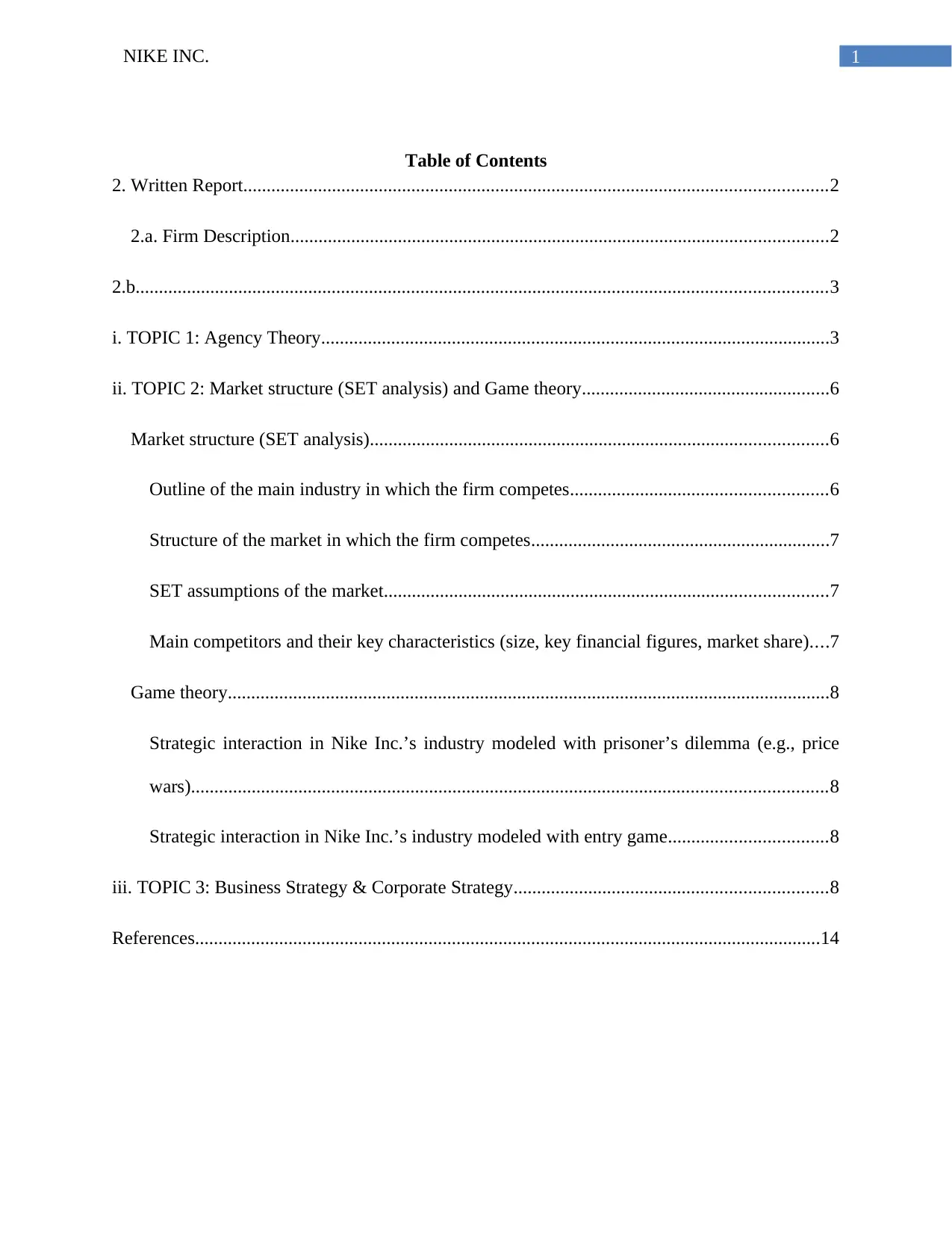
1NIKE INC.
Table of Contents
2. Written Report.............................................................................................................................2
2.a. Firm Description...................................................................................................................2
2.b....................................................................................................................................................3
i. TOPIC 1: Agency Theory.............................................................................................................3
ii. TOPIC 2: Market structure (SET analysis) and Game theory.....................................................6
Market structure (SET analysis)..................................................................................................6
Outline of the main industry in which the firm competes.......................................................6
Structure of the market in which the firm competes................................................................7
SET assumptions of the market...............................................................................................7
Main competitors and their key characteristics (size, key financial figures, market share)....7
Game theory.................................................................................................................................8
Strategic interaction in Nike Inc.’s industry modeled with prisoner’s dilemma (e.g., price
wars)........................................................................................................................................8
Strategic interaction in Nike Inc.’s industry modeled with entry game..................................8
iii. TOPIC 3: Business Strategy & Corporate Strategy...................................................................8
References......................................................................................................................................14
Table of Contents
2. Written Report.............................................................................................................................2
2.a. Firm Description...................................................................................................................2
2.b....................................................................................................................................................3
i. TOPIC 1: Agency Theory.............................................................................................................3
ii. TOPIC 2: Market structure (SET analysis) and Game theory.....................................................6
Market structure (SET analysis)..................................................................................................6
Outline of the main industry in which the firm competes.......................................................6
Structure of the market in which the firm competes................................................................7
SET assumptions of the market...............................................................................................7
Main competitors and their key characteristics (size, key financial figures, market share)....7
Game theory.................................................................................................................................8
Strategic interaction in Nike Inc.’s industry modeled with prisoner’s dilemma (e.g., price
wars)........................................................................................................................................8
Strategic interaction in Nike Inc.’s industry modeled with entry game..................................8
iii. TOPIC 3: Business Strategy & Corporate Strategy...................................................................8
References......................................................................................................................................14
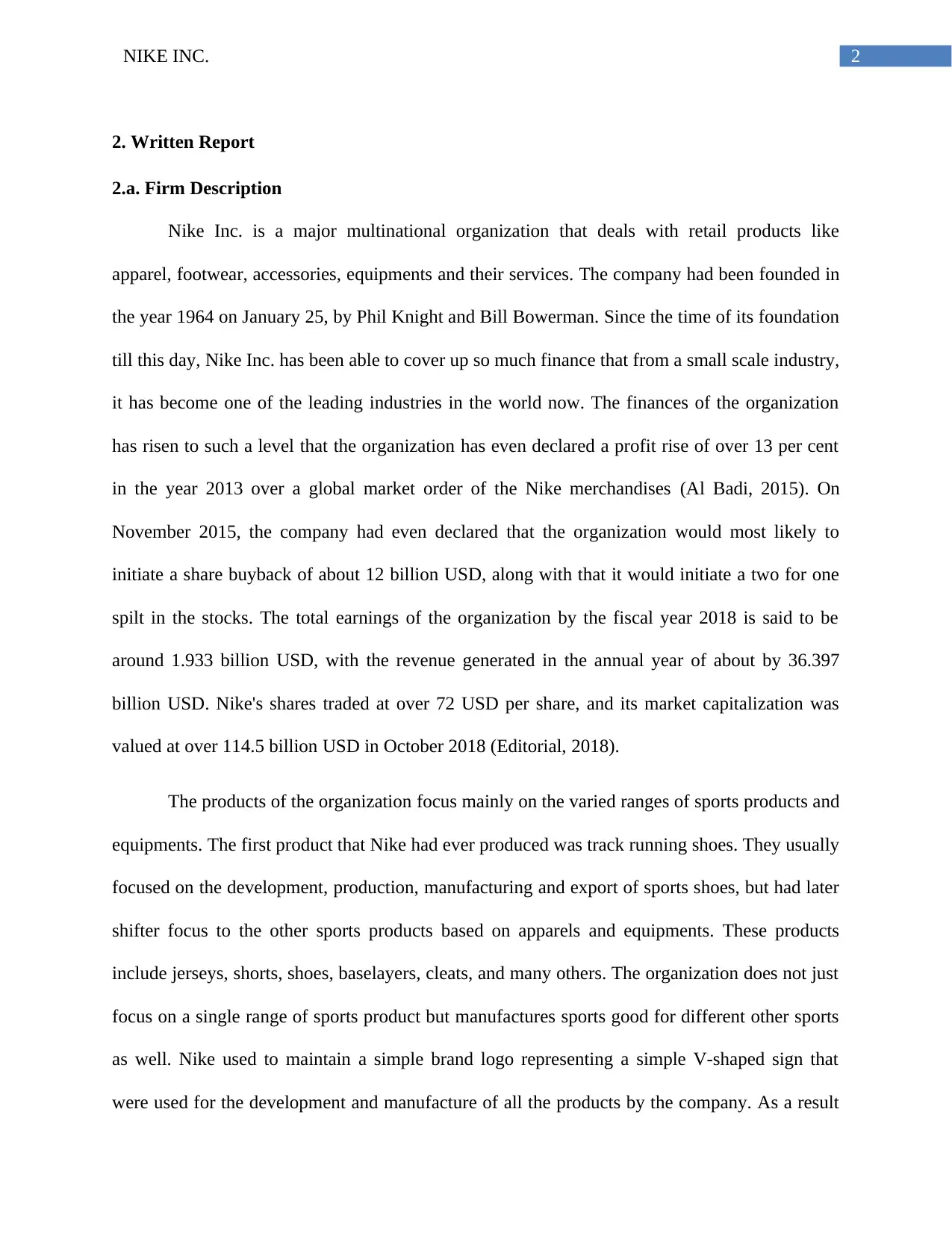
2NIKE INC.
2. Written Report
2.a. Firm Description
Nike Inc. is a major multinational organization that deals with retail products like
apparel, footwear, accessories, equipments and their services. The company had been founded in
the year 1964 on January 25, by Phil Knight and Bill Bowerman. Since the time of its foundation
till this day, Nike Inc. has been able to cover up so much finance that from a small scale industry,
it has become one of the leading industries in the world now. The finances of the organization
has risen to such a level that the organization has even declared a profit rise of over 13 per cent
in the year 2013 over a global market order of the Nike merchandises (Al Badi, 2015). On
November 2015, the company had even declared that the organization would most likely to
initiate a share buyback of about 12 billion USD, along with that it would initiate a two for one
spilt in the stocks. The total earnings of the organization by the fiscal year 2018 is said to be
around 1.933 billion USD, with the revenue generated in the annual year of about by 36.397
billion USD. Nike's shares traded at over 72 USD per share, and its market capitalization was
valued at over 114.5 billion USD in October 2018 (Editorial, 2018).
The products of the organization focus mainly on the varied ranges of sports products and
equipments. The first product that Nike had ever produced was track running shoes. They usually
focused on the development, production, manufacturing and export of sports shoes, but had later
shifter focus to the other sports products based on apparels and equipments. These products
include jerseys, shorts, shoes, baselayers, cleats, and many others. The organization does not just
focus on a single range of sports product but manufactures sports good for different other sports
as well. Nike used to maintain a simple brand logo representing a simple V-shaped sign that
were used for the development and manufacture of all the products by the company. As a result
2. Written Report
2.a. Firm Description
Nike Inc. is a major multinational organization that deals with retail products like
apparel, footwear, accessories, equipments and their services. The company had been founded in
the year 1964 on January 25, by Phil Knight and Bill Bowerman. Since the time of its foundation
till this day, Nike Inc. has been able to cover up so much finance that from a small scale industry,
it has become one of the leading industries in the world now. The finances of the organization
has risen to such a level that the organization has even declared a profit rise of over 13 per cent
in the year 2013 over a global market order of the Nike merchandises (Al Badi, 2015). On
November 2015, the company had even declared that the organization would most likely to
initiate a share buyback of about 12 billion USD, along with that it would initiate a two for one
spilt in the stocks. The total earnings of the organization by the fiscal year 2018 is said to be
around 1.933 billion USD, with the revenue generated in the annual year of about by 36.397
billion USD. Nike's shares traded at over 72 USD per share, and its market capitalization was
valued at over 114.5 billion USD in October 2018 (Editorial, 2018).
The products of the organization focus mainly on the varied ranges of sports products and
equipments. The first product that Nike had ever produced was track running shoes. They usually
focused on the development, production, manufacturing and export of sports shoes, but had later
shifter focus to the other sports products based on apparels and equipments. These products
include jerseys, shorts, shoes, baselayers, cleats, and many others. The organization does not just
focus on a single range of sports product but manufactures sports good for different other sports
as well. Nike used to maintain a simple brand logo representing a simple V-shaped sign that
were used for the development and manufacture of all the products by the company. As a result
⊘ This is a preview!⊘
Do you want full access?
Subscribe today to unlock all pages.

Trusted by 1+ million students worldwide
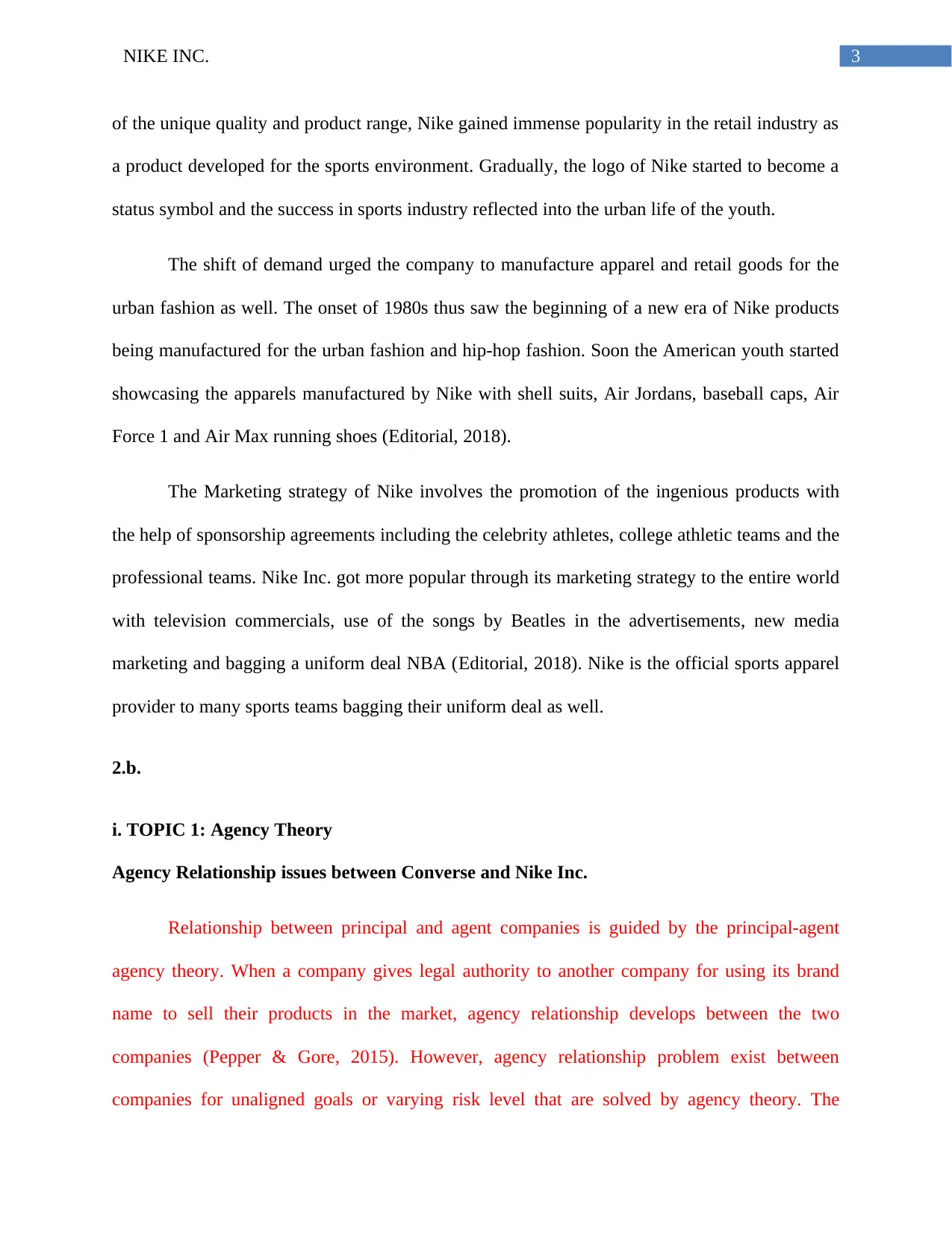
3NIKE INC.
of the unique quality and product range, Nike gained immense popularity in the retail industry as
a product developed for the sports environment. Gradually, the logo of Nike started to become a
status symbol and the success in sports industry reflected into the urban life of the youth.
The shift of demand urged the company to manufacture apparel and retail goods for the
urban fashion as well. The onset of 1980s thus saw the beginning of a new era of Nike products
being manufactured for the urban fashion and hip-hop fashion. Soon the American youth started
showcasing the apparels manufactured by Nike with shell suits, Air Jordans, baseball caps, Air
Force 1 and Air Max running shoes (Editorial, 2018).
The Marketing strategy of Nike involves the promotion of the ingenious products with
the help of sponsorship agreements including the celebrity athletes, college athletic teams and the
professional teams. Nike Inc. got more popular through its marketing strategy to the entire world
with television commercials, use of the songs by Beatles in the advertisements, new media
marketing and bagging a uniform deal NBA (Editorial, 2018). Nike is the official sports apparel
provider to many sports teams bagging their uniform deal as well.
2.b.
i. TOPIC 1: Agency Theory
Agency Relationship issues between Converse and Nike Inc.
Relationship between principal and agent companies is guided by the principal-agent
agency theory. When a company gives legal authority to another company for using its brand
name to sell their products in the market, agency relationship develops between the two
companies (Pepper & Gore, 2015). However, agency relationship problem exist between
companies for unaligned goals or varying risk level that are solved by agency theory. The
of the unique quality and product range, Nike gained immense popularity in the retail industry as
a product developed for the sports environment. Gradually, the logo of Nike started to become a
status symbol and the success in sports industry reflected into the urban life of the youth.
The shift of demand urged the company to manufacture apparel and retail goods for the
urban fashion as well. The onset of 1980s thus saw the beginning of a new era of Nike products
being manufactured for the urban fashion and hip-hop fashion. Soon the American youth started
showcasing the apparels manufactured by Nike with shell suits, Air Jordans, baseball caps, Air
Force 1 and Air Max running shoes (Editorial, 2018).
The Marketing strategy of Nike involves the promotion of the ingenious products with
the help of sponsorship agreements including the celebrity athletes, college athletic teams and the
professional teams. Nike Inc. got more popular through its marketing strategy to the entire world
with television commercials, use of the songs by Beatles in the advertisements, new media
marketing and bagging a uniform deal NBA (Editorial, 2018). Nike is the official sports apparel
provider to many sports teams bagging their uniform deal as well.
2.b.
i. TOPIC 1: Agency Theory
Agency Relationship issues between Converse and Nike Inc.
Relationship between principal and agent companies is guided by the principal-agent
agency theory. When a company gives legal authority to another company for using its brand
name to sell their products in the market, agency relationship develops between the two
companies (Pepper & Gore, 2015). However, agency relationship problem exist between
companies for unaligned goals or varying risk level that are solved by agency theory. The
Paraphrase This Document
Need a fresh take? Get an instant paraphrase of this document with our AI Paraphraser
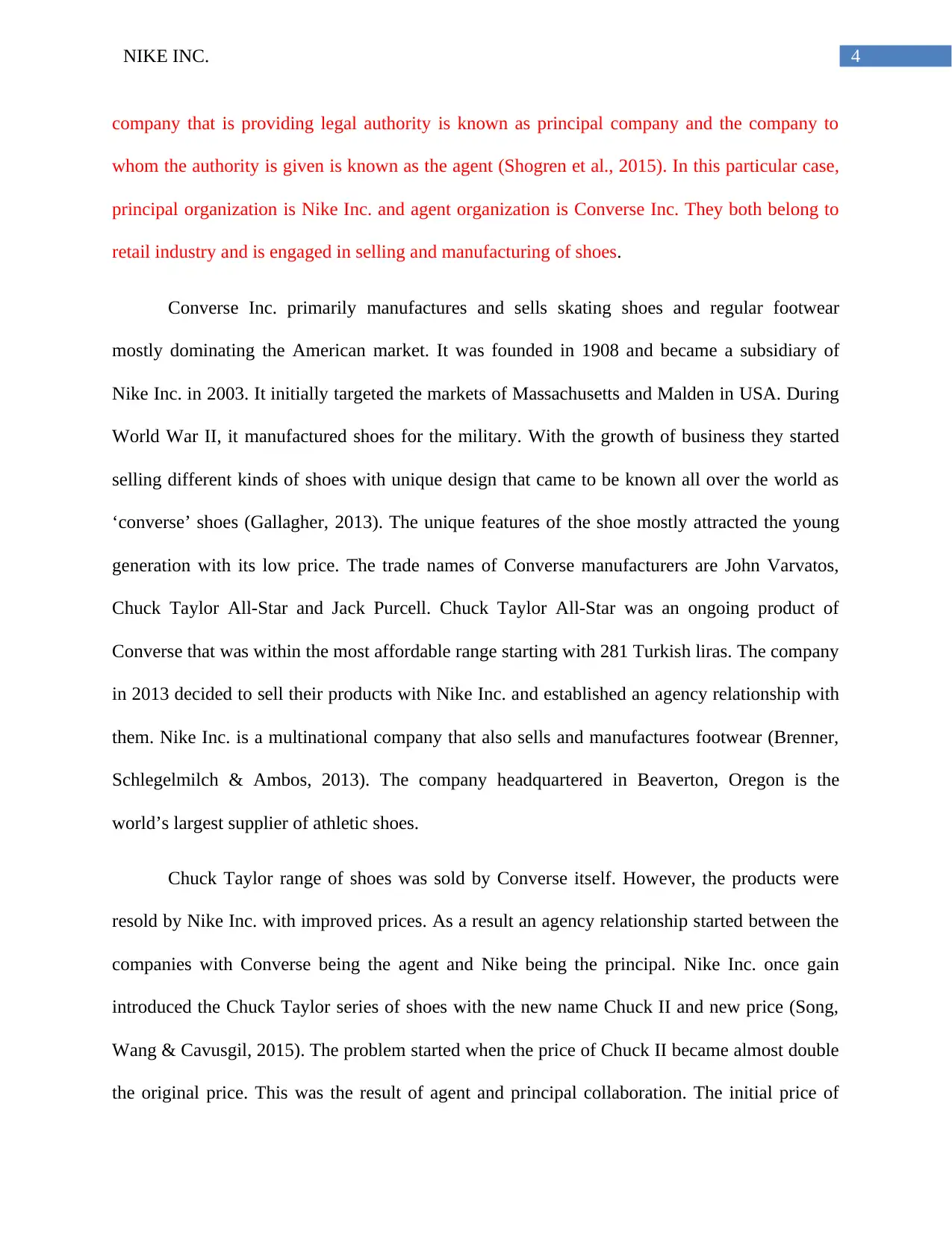
4NIKE INC.
company that is providing legal authority is known as principal company and the company to
whom the authority is given is known as the agent (Shogren et al., 2015). In this particular case,
principal organization is Nike Inc. and agent organization is Converse Inc. They both belong to
retail industry and is engaged in selling and manufacturing of shoes.
Converse Inc. primarily manufactures and sells skating shoes and regular footwear
mostly dominating the American market. It was founded in 1908 and became a subsidiary of
Nike Inc. in 2003. It initially targeted the markets of Massachusetts and Malden in USA. During
World War II, it manufactured shoes for the military. With the growth of business they started
selling different kinds of shoes with unique design that came to be known all over the world as
‘converse’ shoes (Gallagher, 2013). The unique features of the shoe mostly attracted the young
generation with its low price. The trade names of Converse manufacturers are John Varvatos,
Chuck Taylor All-Star and Jack Purcell. Chuck Taylor All-Star was an ongoing product of
Converse that was within the most affordable range starting with 281 Turkish liras. The company
in 2013 decided to sell their products with Nike Inc. and established an agency relationship with
them. Nike Inc. is a multinational company that also sells and manufactures footwear (Brenner,
Schlegelmilch & Ambos, 2013). The company headquartered in Beaverton, Oregon is the
world’s largest supplier of athletic shoes.
Chuck Taylor range of shoes was sold by Converse itself. However, the products were
resold by Nike Inc. with improved prices. As a result an agency relationship started between the
companies with Converse being the agent and Nike being the principal. Nike Inc. once gain
introduced the Chuck Taylor series of shoes with the new name Chuck II and new price (Song,
Wang & Cavusgil, 2015). The problem started when the price of Chuck II became almost double
the original price. This was the result of agent and principal collaboration. The initial price of
company that is providing legal authority is known as principal company and the company to
whom the authority is given is known as the agent (Shogren et al., 2015). In this particular case,
principal organization is Nike Inc. and agent organization is Converse Inc. They both belong to
retail industry and is engaged in selling and manufacturing of shoes.
Converse Inc. primarily manufactures and sells skating shoes and regular footwear
mostly dominating the American market. It was founded in 1908 and became a subsidiary of
Nike Inc. in 2003. It initially targeted the markets of Massachusetts and Malden in USA. During
World War II, it manufactured shoes for the military. With the growth of business they started
selling different kinds of shoes with unique design that came to be known all over the world as
‘converse’ shoes (Gallagher, 2013). The unique features of the shoe mostly attracted the young
generation with its low price. The trade names of Converse manufacturers are John Varvatos,
Chuck Taylor All-Star and Jack Purcell. Chuck Taylor All-Star was an ongoing product of
Converse that was within the most affordable range starting with 281 Turkish liras. The company
in 2013 decided to sell their products with Nike Inc. and established an agency relationship with
them. Nike Inc. is a multinational company that also sells and manufactures footwear (Brenner,
Schlegelmilch & Ambos, 2013). The company headquartered in Beaverton, Oregon is the
world’s largest supplier of athletic shoes.
Chuck Taylor range of shoes was sold by Converse itself. However, the products were
resold by Nike Inc. with improved prices. As a result an agency relationship started between the
companies with Converse being the agent and Nike being the principal. Nike Inc. once gain
introduced the Chuck Taylor series of shoes with the new name Chuck II and new price (Song,
Wang & Cavusgil, 2015). The problem started when the price of Chuck II became almost double
the original price. This was the result of agent and principal collaboration. The initial price of
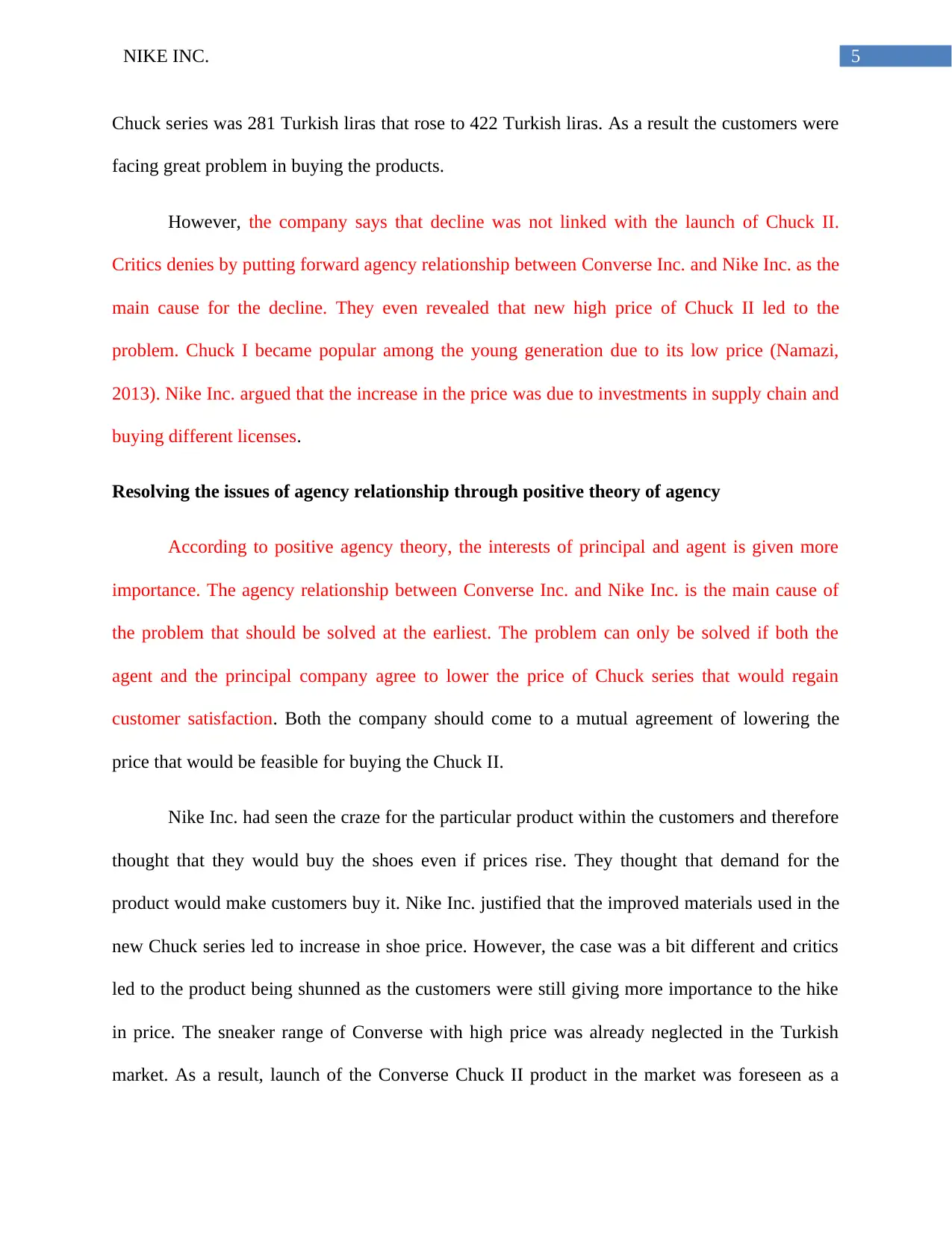
5NIKE INC.
Chuck series was 281 Turkish liras that rose to 422 Turkish liras. As a result the customers were
facing great problem in buying the products.
However, the company says that decline was not linked with the launch of Chuck II.
Critics denies by putting forward agency relationship between Converse Inc. and Nike Inc. as the
main cause for the decline. They even revealed that new high price of Chuck II led to the
problem. Chuck I became popular among the young generation due to its low price (Namazi,
2013). Nike Inc. argued that the increase in the price was due to investments in supply chain and
buying different licenses.
Resolving the issues of agency relationship through positive theory of agency
According to positive agency theory, the interests of principal and agent is given more
importance. The agency relationship between Converse Inc. and Nike Inc. is the main cause of
the problem that should be solved at the earliest. The problem can only be solved if both the
agent and the principal company agree to lower the price of Chuck series that would regain
customer satisfaction. Both the company should come to a mutual agreement of lowering the
price that would be feasible for buying the Chuck II.
Nike Inc. had seen the craze for the particular product within the customers and therefore
thought that they would buy the shoes even if prices rise. They thought that demand for the
product would make customers buy it. Nike Inc. justified that the improved materials used in the
new Chuck series led to increase in shoe price. However, the case was a bit different and critics
led to the product being shunned as the customers were still giving more importance to the hike
in price. The sneaker range of Converse with high price was already neglected in the Turkish
market. As a result, launch of the Converse Chuck II product in the market was foreseen as a
Chuck series was 281 Turkish liras that rose to 422 Turkish liras. As a result the customers were
facing great problem in buying the products.
However, the company says that decline was not linked with the launch of Chuck II.
Critics denies by putting forward agency relationship between Converse Inc. and Nike Inc. as the
main cause for the decline. They even revealed that new high price of Chuck II led to the
problem. Chuck I became popular among the young generation due to its low price (Namazi,
2013). Nike Inc. argued that the increase in the price was due to investments in supply chain and
buying different licenses.
Resolving the issues of agency relationship through positive theory of agency
According to positive agency theory, the interests of principal and agent is given more
importance. The agency relationship between Converse Inc. and Nike Inc. is the main cause of
the problem that should be solved at the earliest. The problem can only be solved if both the
agent and the principal company agree to lower the price of Chuck series that would regain
customer satisfaction. Both the company should come to a mutual agreement of lowering the
price that would be feasible for buying the Chuck II.
Nike Inc. had seen the craze for the particular product within the customers and therefore
thought that they would buy the shoes even if prices rise. They thought that demand for the
product would make customers buy it. Nike Inc. justified that the improved materials used in the
new Chuck series led to increase in shoe price. However, the case was a bit different and critics
led to the product being shunned as the customers were still giving more importance to the hike
in price. The sneaker range of Converse with high price was already neglected in the Turkish
market. As a result, launch of the Converse Chuck II product in the market was foreseen as a
⊘ This is a preview!⊘
Do you want full access?
Subscribe today to unlock all pages.

Trusted by 1+ million students worldwide
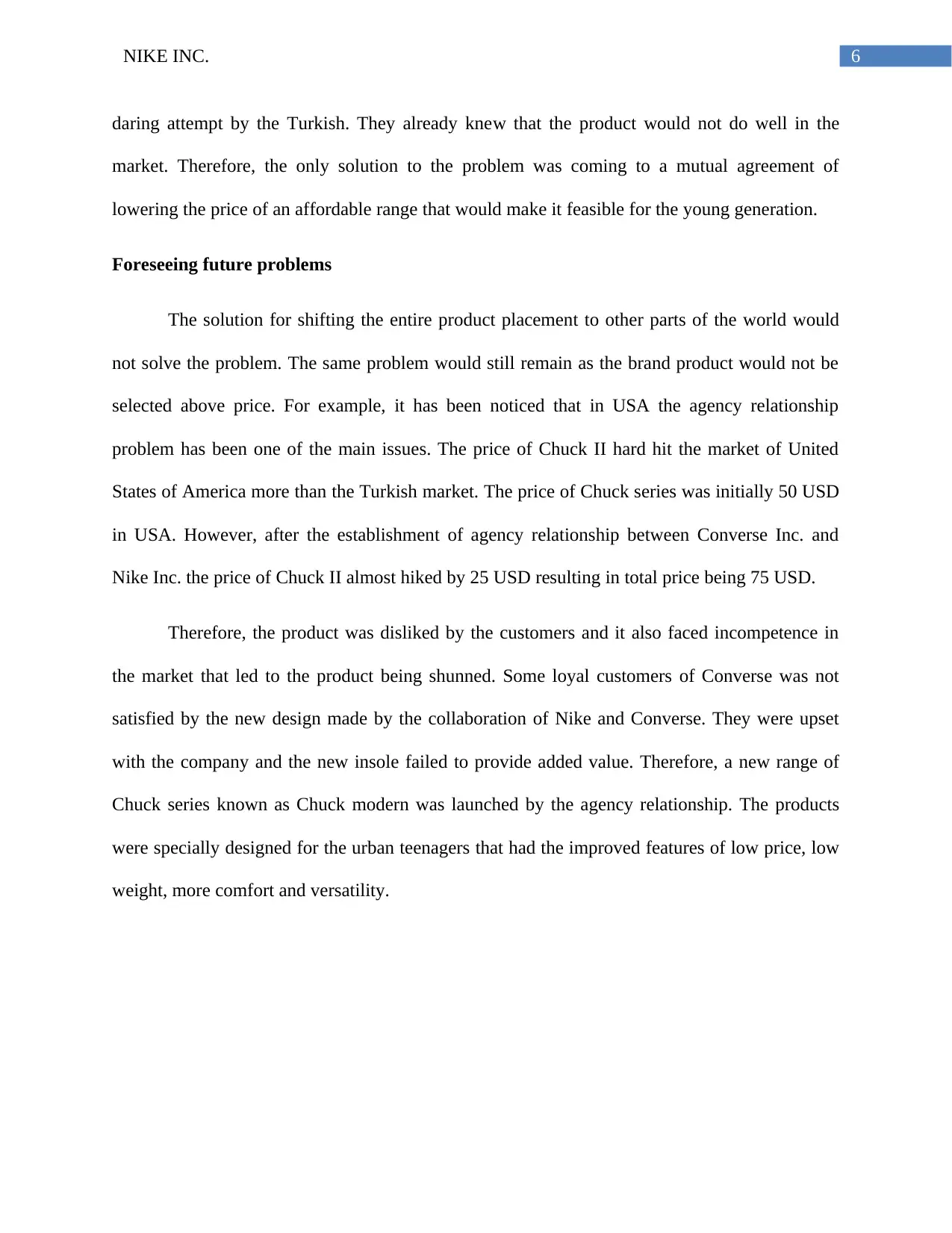
6NIKE INC.
daring attempt by the Turkish. They already knew that the product would not do well in the
market. Therefore, the only solution to the problem was coming to a mutual agreement of
lowering the price of an affordable range that would make it feasible for the young generation.
Foreseeing future problems
The solution for shifting the entire product placement to other parts of the world would
not solve the problem. The same problem would still remain as the brand product would not be
selected above price. For example, it has been noticed that in USA the agency relationship
problem has been one of the main issues. The price of Chuck II hard hit the market of United
States of America more than the Turkish market. The price of Chuck series was initially 50 USD
in USA. However, after the establishment of agency relationship between Converse Inc. and
Nike Inc. the price of Chuck II almost hiked by 25 USD resulting in total price being 75 USD.
Therefore, the product was disliked by the customers and it also faced incompetence in
the market that led to the product being shunned. Some loyal customers of Converse was not
satisfied by the new design made by the collaboration of Nike and Converse. They were upset
with the company and the new insole failed to provide added value. Therefore, a new range of
Chuck series known as Chuck modern was launched by the agency relationship. The products
were specially designed for the urban teenagers that had the improved features of low price, low
weight, more comfort and versatility.
daring attempt by the Turkish. They already knew that the product would not do well in the
market. Therefore, the only solution to the problem was coming to a mutual agreement of
lowering the price of an affordable range that would make it feasible for the young generation.
Foreseeing future problems
The solution for shifting the entire product placement to other parts of the world would
not solve the problem. The same problem would still remain as the brand product would not be
selected above price. For example, it has been noticed that in USA the agency relationship
problem has been one of the main issues. The price of Chuck II hard hit the market of United
States of America more than the Turkish market. The price of Chuck series was initially 50 USD
in USA. However, after the establishment of agency relationship between Converse Inc. and
Nike Inc. the price of Chuck II almost hiked by 25 USD resulting in total price being 75 USD.
Therefore, the product was disliked by the customers and it also faced incompetence in
the market that led to the product being shunned. Some loyal customers of Converse was not
satisfied by the new design made by the collaboration of Nike and Converse. They were upset
with the company and the new insole failed to provide added value. Therefore, a new range of
Chuck series known as Chuck modern was launched by the agency relationship. The products
were specially designed for the urban teenagers that had the improved features of low price, low
weight, more comfort and versatility.
Paraphrase This Document
Need a fresh take? Get an instant paraphrase of this document with our AI Paraphraser
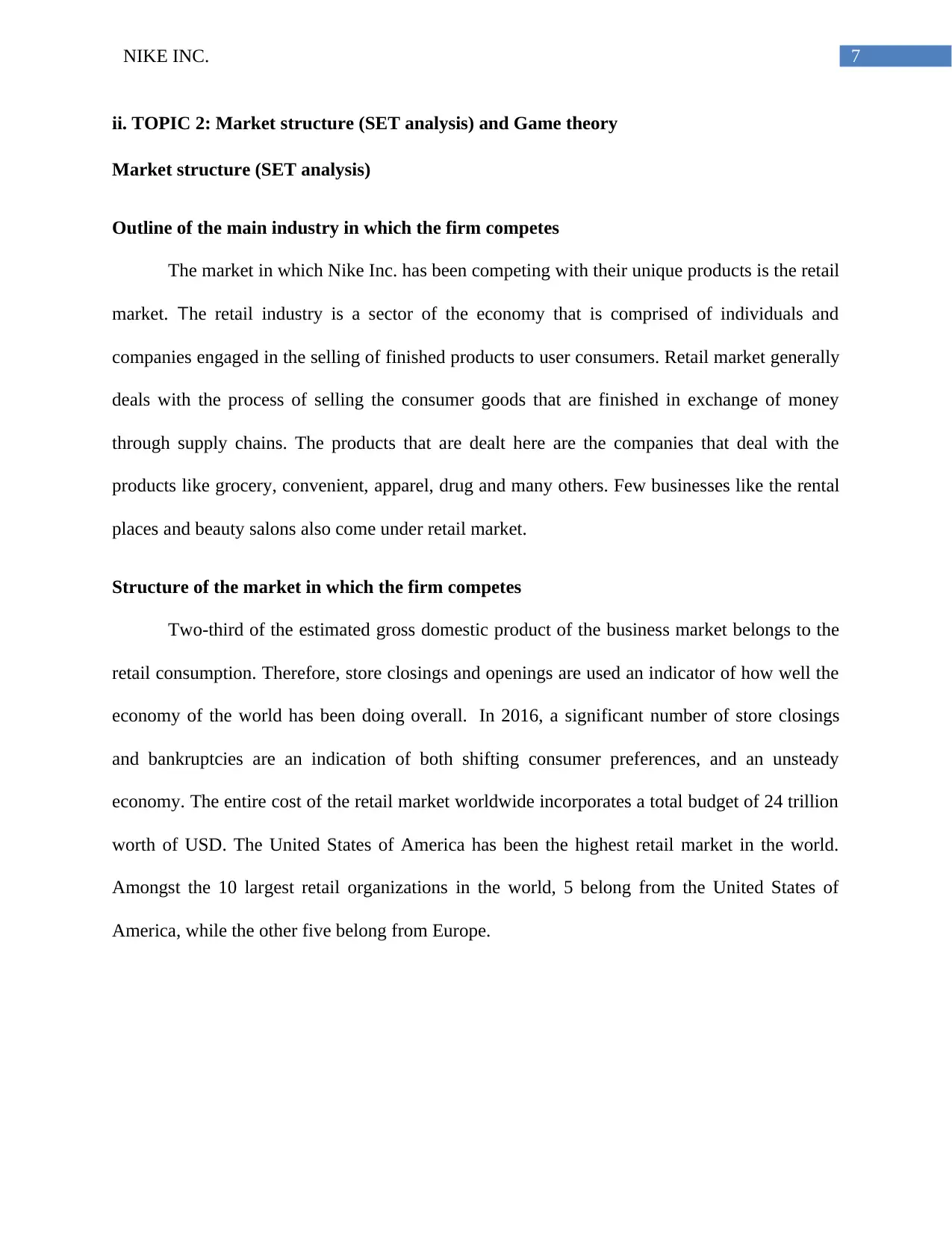
7NIKE INC.
ii. TOPIC 2: Market structure (SET analysis) and Game theory
Market structure (SET analysis)
Outline of the main industry in which the firm competes
The market in which Nike Inc. has been competing with their unique products is the retail
market. The retail industry is a sector of the economy that is comprised of individuals and
companies engaged in the selling of finished products to user consumers. Retail market generally
deals with the process of selling the consumer goods that are finished in exchange of money
through supply chains. The products that are dealt here are the companies that deal with the
products like grocery, convenient, apparel, drug and many others. Few businesses like the rental
places and beauty salons also come under retail market.
Structure of the market in which the firm competes
Two-third of the estimated gross domestic product of the business market belongs to the
retail consumption. Therefore, store closings and openings are used an indicator of how well the
economy of the world has been doing overall. In 2016, a significant number of store closings
and bankruptcies are an indication of both shifting consumer preferences, and an unsteady
economy. The entire cost of the retail market worldwide incorporates a total budget of 24 trillion
worth of USD. The United States of America has been the highest retail market in the world.
Amongst the 10 largest retail organizations in the world, 5 belong from the United States of
America, while the other five belong from Europe.
ii. TOPIC 2: Market structure (SET analysis) and Game theory
Market structure (SET analysis)
Outline of the main industry in which the firm competes
The market in which Nike Inc. has been competing with their unique products is the retail
market. The retail industry is a sector of the economy that is comprised of individuals and
companies engaged in the selling of finished products to user consumers. Retail market generally
deals with the process of selling the consumer goods that are finished in exchange of money
through supply chains. The products that are dealt here are the companies that deal with the
products like grocery, convenient, apparel, drug and many others. Few businesses like the rental
places and beauty salons also come under retail market.
Structure of the market in which the firm competes
Two-third of the estimated gross domestic product of the business market belongs to the
retail consumption. Therefore, store closings and openings are used an indicator of how well the
economy of the world has been doing overall. In 2016, a significant number of store closings
and bankruptcies are an indication of both shifting consumer preferences, and an unsteady
economy. The entire cost of the retail market worldwide incorporates a total budget of 24 trillion
worth of USD. The United States of America has been the highest retail market in the world.
Amongst the 10 largest retail organizations in the world, 5 belong from the United States of
America, while the other five belong from Europe.
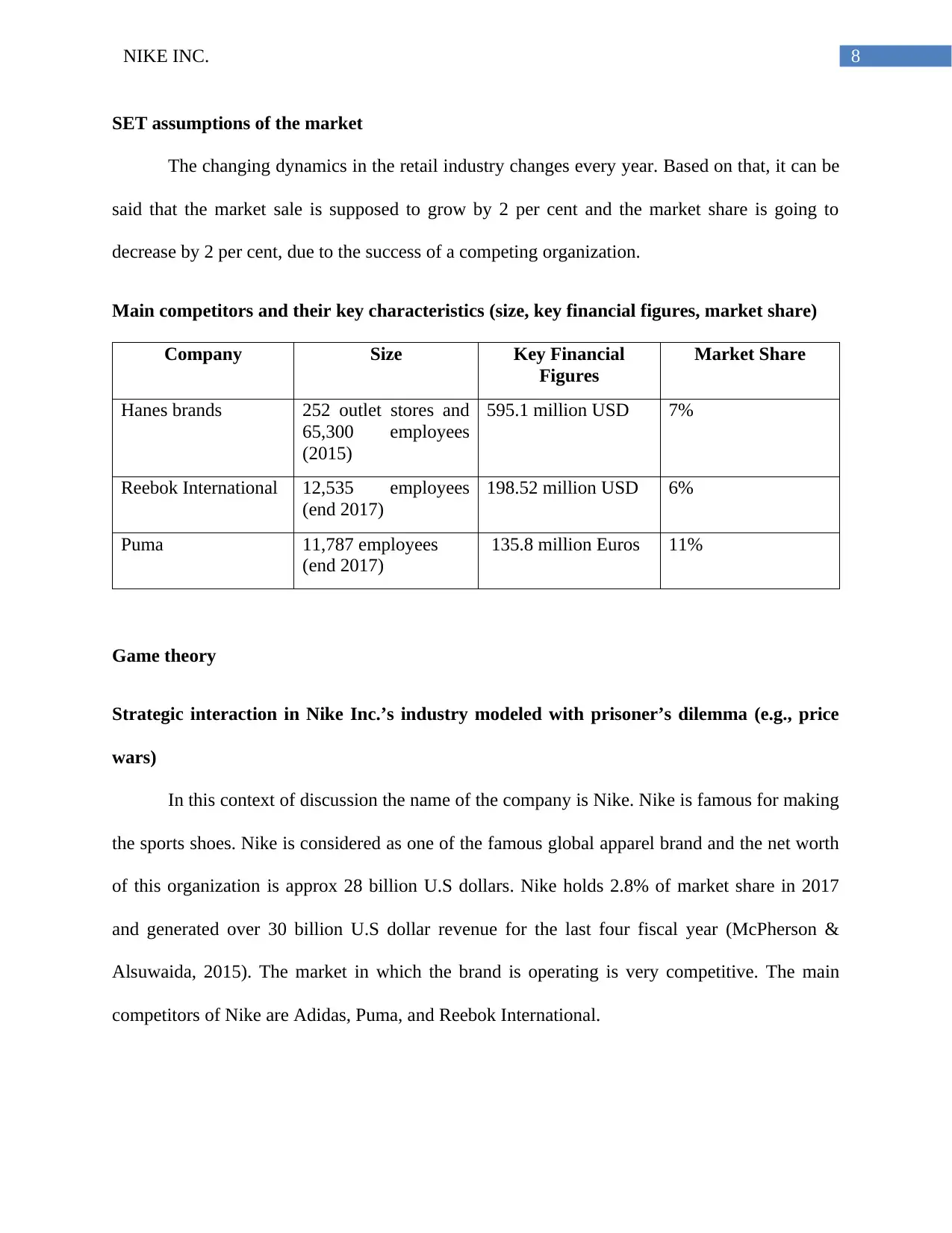
8NIKE INC.
SET assumptions of the market
The changing dynamics in the retail industry changes every year. Based on that, it can be
said that the market sale is supposed to grow by 2 per cent and the market share is going to
decrease by 2 per cent, due to the success of a competing organization.
Main competitors and their key characteristics (size, key financial figures, market share)
Company Size Key Financial
Figures
Market Share
Hanes brands 252 outlet stores and
65,300 employees
(2015)
595.1 million USD 7%
Reebok International 12,535 employees
(end 2017)
198.52 million USD 6%
Puma 11,787 employees
(end 2017)
135.8 million Euros 11%
Game theory
Strategic interaction in Nike Inc.’s industry modeled with prisoner’s dilemma (e.g., price
wars)
In this context of discussion the name of the company is Nike. Nike is famous for making
the sports shoes. Nike is considered as one of the famous global apparel brand and the net worth
of this organization is approx 28 billion U.S dollars. Nike holds 2.8% of market share in 2017
and generated over 30 billion U.S dollar revenue for the last four fiscal year (McPherson &
Alsuwaida, 2015). The market in which the brand is operating is very competitive. The main
competitors of Nike are Adidas, Puma, and Reebok International.
SET assumptions of the market
The changing dynamics in the retail industry changes every year. Based on that, it can be
said that the market sale is supposed to grow by 2 per cent and the market share is going to
decrease by 2 per cent, due to the success of a competing organization.
Main competitors and their key characteristics (size, key financial figures, market share)
Company Size Key Financial
Figures
Market Share
Hanes brands 252 outlet stores and
65,300 employees
(2015)
595.1 million USD 7%
Reebok International 12,535 employees
(end 2017)
198.52 million USD 6%
Puma 11,787 employees
(end 2017)
135.8 million Euros 11%
Game theory
Strategic interaction in Nike Inc.’s industry modeled with prisoner’s dilemma (e.g., price
wars)
In this context of discussion the name of the company is Nike. Nike is famous for making
the sports shoes. Nike is considered as one of the famous global apparel brand and the net worth
of this organization is approx 28 billion U.S dollars. Nike holds 2.8% of market share in 2017
and generated over 30 billion U.S dollar revenue for the last four fiscal year (McPherson &
Alsuwaida, 2015). The market in which the brand is operating is very competitive. The main
competitors of Nike are Adidas, Puma, and Reebok International.
⊘ This is a preview!⊘
Do you want full access?
Subscribe today to unlock all pages.

Trusted by 1+ million students worldwide
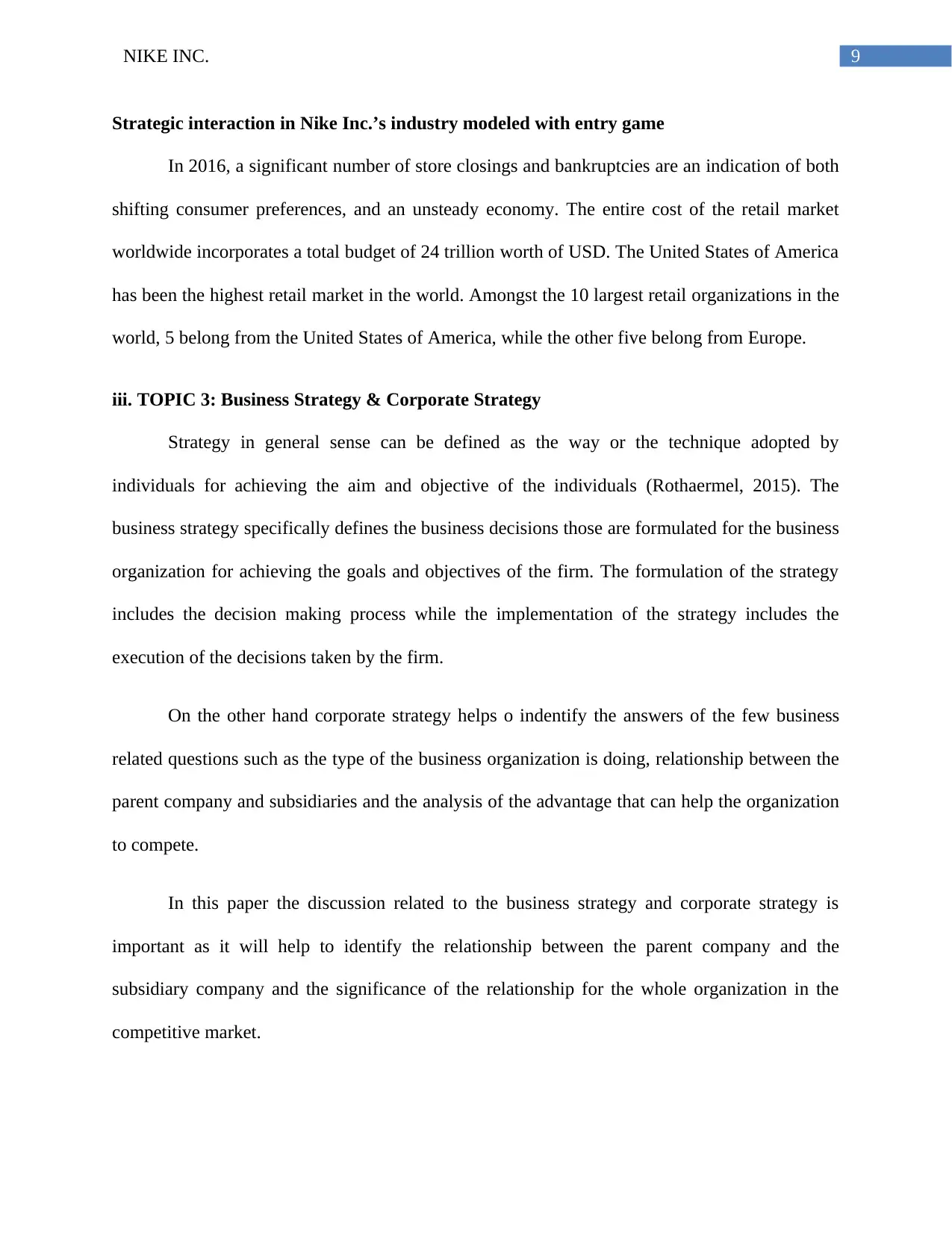
9NIKE INC.
Strategic interaction in Nike Inc.’s industry modeled with entry game
In 2016, a significant number of store closings and bankruptcies are an indication of both
shifting consumer preferences, and an unsteady economy. The entire cost of the retail market
worldwide incorporates a total budget of 24 trillion worth of USD. The United States of America
has been the highest retail market in the world. Amongst the 10 largest retail organizations in the
world, 5 belong from the United States of America, while the other five belong from Europe.
iii. TOPIC 3: Business Strategy & Corporate Strategy
Strategy in general sense can be defined as the way or the technique adopted by
individuals for achieving the aim and objective of the individuals (Rothaermel, 2015). The
business strategy specifically defines the business decisions those are formulated for the business
organization for achieving the goals and objectives of the firm. The formulation of the strategy
includes the decision making process while the implementation of the strategy includes the
execution of the decisions taken by the firm.
On the other hand corporate strategy helps o indentify the answers of the few business
related questions such as the type of the business organization is doing, relationship between the
parent company and subsidiaries and the analysis of the advantage that can help the organization
to compete.
In this paper the discussion related to the business strategy and corporate strategy is
important as it will help to identify the relationship between the parent company and the
subsidiary company and the significance of the relationship for the whole organization in the
competitive market.
Strategic interaction in Nike Inc.’s industry modeled with entry game
In 2016, a significant number of store closings and bankruptcies are an indication of both
shifting consumer preferences, and an unsteady economy. The entire cost of the retail market
worldwide incorporates a total budget of 24 trillion worth of USD. The United States of America
has been the highest retail market in the world. Amongst the 10 largest retail organizations in the
world, 5 belong from the United States of America, while the other five belong from Europe.
iii. TOPIC 3: Business Strategy & Corporate Strategy
Strategy in general sense can be defined as the way or the technique adopted by
individuals for achieving the aim and objective of the individuals (Rothaermel, 2015). The
business strategy specifically defines the business decisions those are formulated for the business
organization for achieving the goals and objectives of the firm. The formulation of the strategy
includes the decision making process while the implementation of the strategy includes the
execution of the decisions taken by the firm.
On the other hand corporate strategy helps o indentify the answers of the few business
related questions such as the type of the business organization is doing, relationship between the
parent company and subsidiaries and the analysis of the advantage that can help the organization
to compete.
In this paper the discussion related to the business strategy and corporate strategy is
important as it will help to identify the relationship between the parent company and the
subsidiary company and the significance of the relationship for the whole organization in the
competitive market.
Paraphrase This Document
Need a fresh take? Get an instant paraphrase of this document with our AI Paraphraser
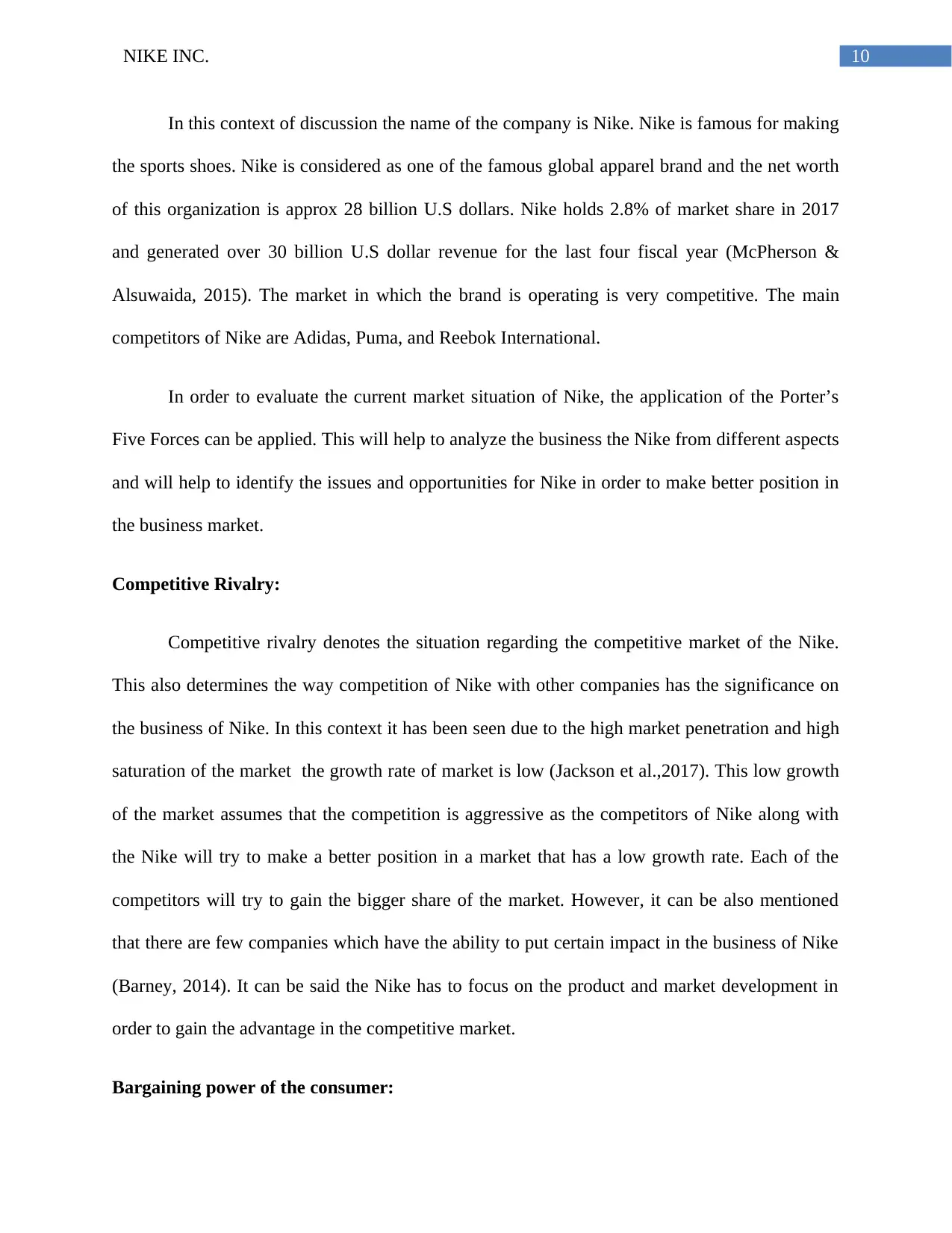
10NIKE INC.
In this context of discussion the name of the company is Nike. Nike is famous for making
the sports shoes. Nike is considered as one of the famous global apparel brand and the net worth
of this organization is approx 28 billion U.S dollars. Nike holds 2.8% of market share in 2017
and generated over 30 billion U.S dollar revenue for the last four fiscal year (McPherson &
Alsuwaida, 2015). The market in which the brand is operating is very competitive. The main
competitors of Nike are Adidas, Puma, and Reebok International.
In order to evaluate the current market situation of Nike, the application of the Porter’s
Five Forces can be applied. This will help to analyze the business the Nike from different aspects
and will help to identify the issues and opportunities for Nike in order to make better position in
the business market.
Competitive Rivalry:
Competitive rivalry denotes the situation regarding the competitive market of the Nike.
This also determines the way competition of Nike with other companies has the significance on
the business of Nike. In this context it has been seen due to the high market penetration and high
saturation of the market the growth rate of market is low (Jackson et al.,2017). This low growth
of the market assumes that the competition is aggressive as the competitors of Nike along with
the Nike will try to make a better position in a market that has a low growth rate. Each of the
competitors will try to gain the bigger share of the market. However, it can be also mentioned
that there are few companies which have the ability to put certain impact in the business of Nike
(Barney, 2014). It can be said the Nike has to focus on the product and market development in
order to gain the advantage in the competitive market.
Bargaining power of the consumer:
In this context of discussion the name of the company is Nike. Nike is famous for making
the sports shoes. Nike is considered as one of the famous global apparel brand and the net worth
of this organization is approx 28 billion U.S dollars. Nike holds 2.8% of market share in 2017
and generated over 30 billion U.S dollar revenue for the last four fiscal year (McPherson &
Alsuwaida, 2015). The market in which the brand is operating is very competitive. The main
competitors of Nike are Adidas, Puma, and Reebok International.
In order to evaluate the current market situation of Nike, the application of the Porter’s
Five Forces can be applied. This will help to analyze the business the Nike from different aspects
and will help to identify the issues and opportunities for Nike in order to make better position in
the business market.
Competitive Rivalry:
Competitive rivalry denotes the situation regarding the competitive market of the Nike.
This also determines the way competition of Nike with other companies has the significance on
the business of Nike. In this context it has been seen due to the high market penetration and high
saturation of the market the growth rate of market is low (Jackson et al.,2017). This low growth
of the market assumes that the competition is aggressive as the competitors of Nike along with
the Nike will try to make a better position in a market that has a low growth rate. Each of the
competitors will try to gain the bigger share of the market. However, it can be also mentioned
that there are few companies which have the ability to put certain impact in the business of Nike
(Barney, 2014). It can be said the Nike has to focus on the product and market development in
order to gain the advantage in the competitive market.
Bargaining power of the consumer:
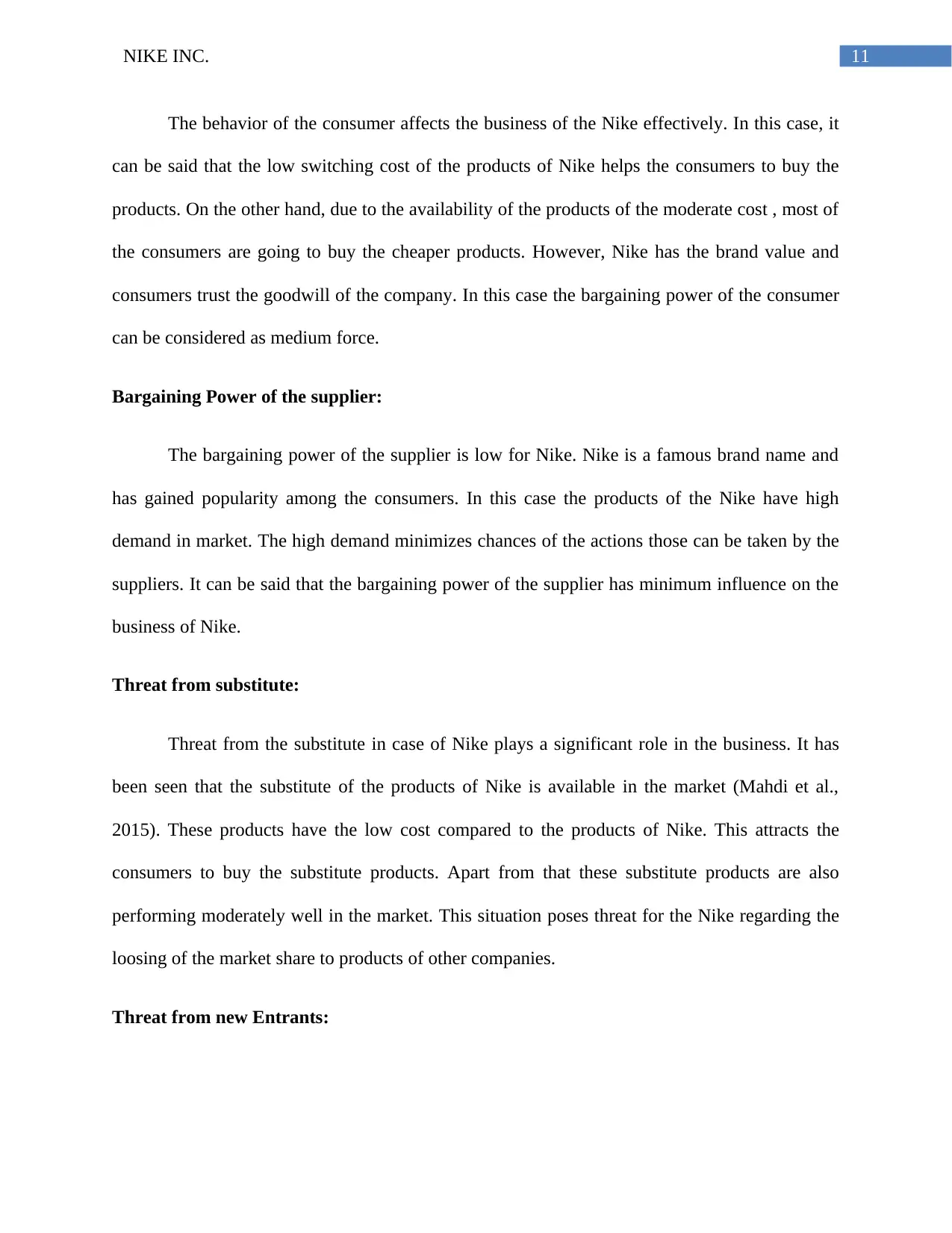
11NIKE INC.
The behavior of the consumer affects the business of the Nike effectively. In this case, it
can be said that the low switching cost of the products of Nike helps the consumers to buy the
products. On the other hand, due to the availability of the products of the moderate cost , most of
the consumers are going to buy the cheaper products. However, Nike has the brand value and
consumers trust the goodwill of the company. In this case the bargaining power of the consumer
can be considered as medium force.
Bargaining Power of the supplier:
The bargaining power of the supplier is low for Nike. Nike is a famous brand name and
has gained popularity among the consumers. In this case the products of the Nike have high
demand in market. The high demand minimizes chances of the actions those can be taken by the
suppliers. It can be said that the bargaining power of the supplier has minimum influence on the
business of Nike.
Threat from substitute:
Threat from the substitute in case of Nike plays a significant role in the business. It has
been seen that the substitute of the products of Nike is available in the market (Mahdi et al.,
2015). These products have the low cost compared to the products of Nike. This attracts the
consumers to buy the substitute products. Apart from that these substitute products are also
performing moderately well in the market. This situation poses threat for the Nike regarding the
loosing of the market share to products of other companies.
Threat from new Entrants:
The behavior of the consumer affects the business of the Nike effectively. In this case, it
can be said that the low switching cost of the products of Nike helps the consumers to buy the
products. On the other hand, due to the availability of the products of the moderate cost , most of
the consumers are going to buy the cheaper products. However, Nike has the brand value and
consumers trust the goodwill of the company. In this case the bargaining power of the consumer
can be considered as medium force.
Bargaining Power of the supplier:
The bargaining power of the supplier is low for Nike. Nike is a famous brand name and
has gained popularity among the consumers. In this case the products of the Nike have high
demand in market. The high demand minimizes chances of the actions those can be taken by the
suppliers. It can be said that the bargaining power of the supplier has minimum influence on the
business of Nike.
Threat from substitute:
Threat from the substitute in case of Nike plays a significant role in the business. It has
been seen that the substitute of the products of Nike is available in the market (Mahdi et al.,
2015). These products have the low cost compared to the products of Nike. This attracts the
consumers to buy the substitute products. Apart from that these substitute products are also
performing moderately well in the market. This situation poses threat for the Nike regarding the
loosing of the market share to products of other companies.
Threat from new Entrants:
⊘ This is a preview!⊘
Do you want full access?
Subscribe today to unlock all pages.

Trusted by 1+ million students worldwide
1 out of 18
Related Documents
Your All-in-One AI-Powered Toolkit for Academic Success.
+13062052269
info@desklib.com
Available 24*7 on WhatsApp / Email
![[object Object]](/_next/static/media/star-bottom.7253800d.svg)
Unlock your academic potential
Copyright © 2020–2025 A2Z Services. All Rights Reserved. Developed and managed by ZUCOL.





